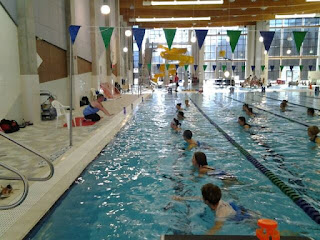Handout - When exercising in water, I sometimes feel a pinch at my tailbone. What am I doing wrong?
Q: When exercising in water, I sometimes
feel a pinch at my tailbone. What am I doing wrong?
Acute pain may occur suddenly while
exercising. Causes vary and depend on form, technique, fitness ability,
muscular strength, any previous injuries to the specific area, etc. Pain could
be mild to severe in intensity. In both land and water fitness, causes may
include an abrupt offset of balance, misalignment of the spine, or unequal body
weight bearing. Acute trauma may also result from excessive joint loading, ignoring
any physical limitations or exceeding the appropriate range of motion at a
particular joint. When exercising in an aquatic environment, it is important be
aware of the forces generated while moving water. Water is more dense and
heavier than air, thereby offering the potential for strong resistance.
Balance, footing and stability are always challenged, as buoyancy, turbulence,
and eddies (currents) all affect the body. Turbulence and currents generated by
the movements of others nearby will also affect your stability. If you become
off-balanced, stop the motion and re-adjust your form/stance. A sudden pinch or pain should NEVER be ignored.
If you feel a sharp pain, pinch or stab, STOP immediately. (Feeling pain is
very different from feeling physically uncomfortable or challenged!)
Proper posture is vital. Throughout a movement, maintain the spine
and neck in neutral: long or “tall”. (Exception: In abdominal crunches, the
spine is flexed, with the back, neck and shoulders slightly rounded and the chin
slightly dropped. Any form of an ab
crunch on land or a suspended ab crunch done in water should NEVER be performed
with a straight spine or neck.) When standing while exercising, keep feet a
minimum of hip-width apart for improved
balance. In water, this safe stance is important in light bounce, propulsion or
anchored movements.
Avoid an unreasonably wide stance as
this will increase the demand and stress placed on the sacroiliac and lumbar
zone of the back. Perform forward lean movements from the hip flexors to lessen
the chance of lower back strain. By contrast, avoid excessively arching the
lower back (hyper-extension). Similarly, perform posterior leg lifts with the
hips in neutral and ‘gluteals’ activated. This awareness will limit the height
of the leg lift and protect the low back as well.
Keep hips “squared” (horizontally equal,
in neutral); and avoid slouching by maintaining and open posture, with scapula
retracted and shoulders relaxed. Also, keep the knees “tracked” in line with
the feet, never buckled in (hyper-extended), with the toes pointing forward.
Meanwhile, avoid straight legs with “locked” knees (95% only for maximum
extension). Maintain relaxed shoulders. Keep
the shoulders “square” and positioned in line with the hips.
Activate the muscles of the inner unit,
often referred to as the core: draw the navel gently towards the spine, without
tilting the pelvis, this action will result in transverse abdominus activation.
Also lift the pelvic floor (pubo-coccygeal muscles) by performing Kegel’s.
Finally, connect the ribs and hips anteriorly, posteriorly and laterally with
specific focus on activating the deep multifidus muscle in the low back region.
Do yourself a favour and look up these
muscles on the internet to get a picture of where they are in your body!
Control all movements and keep them within
a comfortable range of motion for each joint. Above all, listen to your body.
Contact: absfit@cogeco.ca OR: http://home.cogeco.ca/~absfit


.jpg)
Comments
Post a Comment